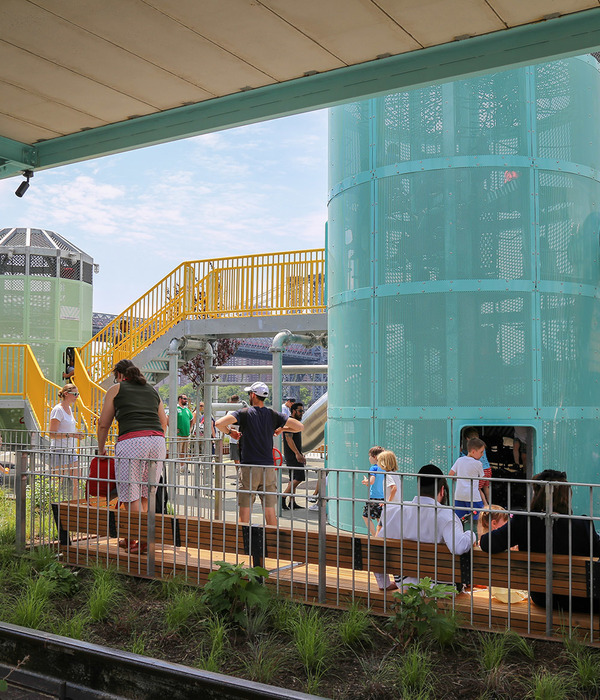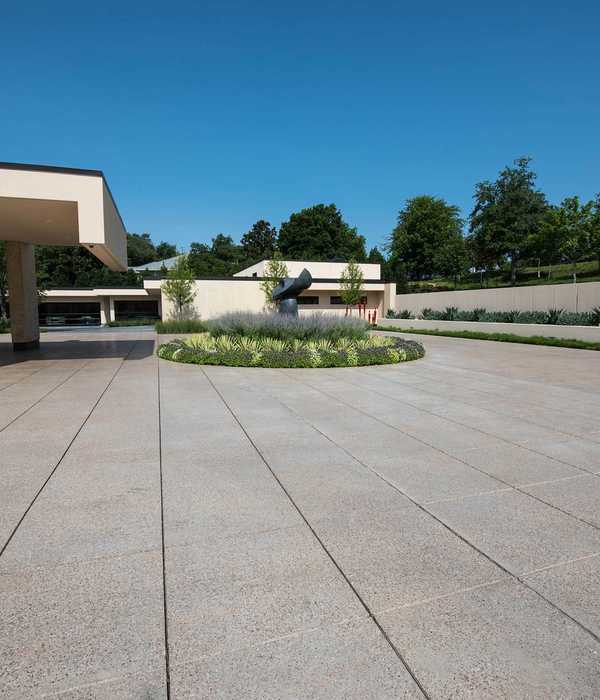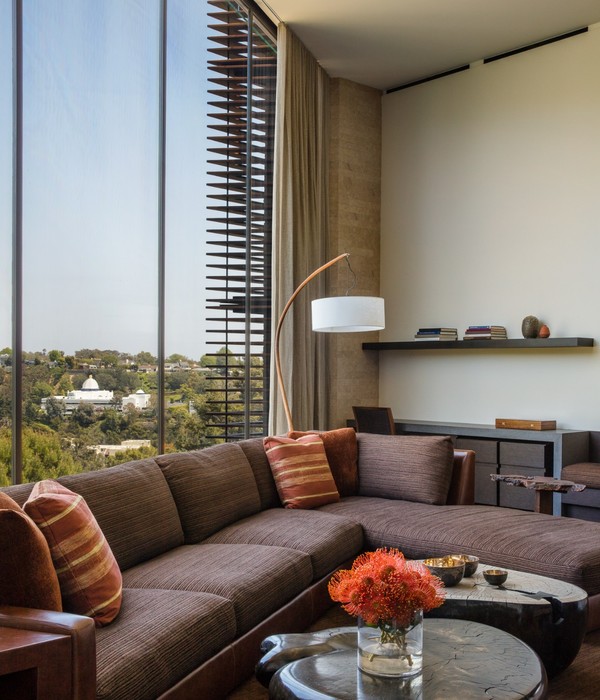- 项目名称:南京战斗机械厂改造更新(红创PARK)
- 项目地址:南京市鼓楼区黄家圩路41-1号红山科技创新工厂
- 项目业主:南京工程机械厂有限公司
- 项目主创:米思建筑
- 结构顾问:上海源规建筑结构设计事务所
- 灯光顾问:麓米照明设计(上海)有限公司(F16号红色清水混凝土楼)
- 建筑施工图设计:南京兴华建筑设计研究院股份有限公司
- 标识设计:南京拾野文化传播有限公司
- 施工团队:南京千才建设工程有限公司(建筑),南京恒子环境工程有限公司(景观),倍砼堡BETONBAU上海可建新材料科技有限公司(F16号红色清水混凝土楼)
- 建筑材料:红砖,清水混凝土,水磨石,耐候钢,铝,玻璃
- 设计时间:2020年12月—2021年7月
- 竣工时间:2023年4月
- 建筑面积:11224平方米
- 摄影:孙海霆,吕晓斌,存在建筑-建筑摄影
南京战斗机械厂改造更新
Renovation of Nanjing Combat Machinery Factory
场地鸟瞰 ©吕晓斌
南京战斗机械厂位于城北红山西麓,紧邻南京火车站。厂区始建于上世纪50年代,随着城市的扩张和产业变迁,生产功能被逐步外迁,原始厂区逐渐闲置。
Nanjing Combat Machinery Factory is located on the west side of Hongshan in the north of the city, which is nearby the Nanjing Railway Station. The factory was built in the 1950s. With the expansion of the city and industrial development, the production department moved out, which leads to the idling of the original factory.
城市区位鸟瞰 ©存在建筑-建筑摄影
厂区入口老照片
厂区主路及林荫道老照片
2006年前后,厂区曾经历一次改造,以创意产业园之名重新营业,却没能重现活力。经历改造的厂区被新建墙体、面砖铺贴、粉刷修饰掩藏了曾经工业记忆的痕迹。近二十年来,红山茂密的植被逐步向厂区蔓延,进一步包裹住建筑的真相,被自然侵蚀的厂区成为城市与山林的边缘地带,被人们遗忘,被城市遗忘。
Around 2006, people tried to renew the factory, hoping to reopen it as the creative industrial center. However, for some reason, the building failed to attract people’s attention even though it is renewed. After the renconstruction, the new walls were built, bricks were paved, and the whole building was painted, which hides industrial memory. In the past 20 years, the vegetation gradually spreads to the factory area, trying to cover the facade of the factory. The factory is corroding by nature, standing at the edge of the community, and forgotten by the people and city.
厂区原状鸟瞰
入口广场区域(左)、林荫主干道(右)原状
沿山组团(左)、内部道路(右)原状 供图:米思建筑
2020年底,业主委托米思对厂区进行改造更新,希望使其成为以办公为主体的复合型新兴园区。设计的首要任务是唤醒厂区记忆,恢复园区活力。在保留已有自然树木的前提下,这次设计希望展露建筑中历史的痕迹,并重新回归城市。
At the end of 2020, the owner entrusted MIX Architecture to renovate and update the factory, hoping to make it a composite emerging park with office as the main body. Besides protecting the existing trees, architects need to show the history of the building and make the renovated building able to follow the language of the city.
连廊与入口组团形成入口引导空间 ©存在建筑-建筑摄影
连廊与入口组团 ©孙海霆
连廊连接综合楼与模具车间 ©孙海霆
连廊与综合楼 ©孙海霆
综合楼 ©孙海霆
设计提取原有厂区建筑群中最重要的特征——红砖清水墙面,以一种看似严肃却又轻松的方式重塑园区—— 一片位于“红山”脚下,带着某些特定“红色记忆”的“红色”建筑。材料的特征和共性成为统一园区并重新唤醒记忆的关键。红砖、红色清水混凝土、红色水磨石、红色面砖,用各种带有不同时代特征的红色材料,代表不同年代的建造方式和构造方法,强化“红色”特征。
During the design process, we were inspired by the most attractive characteristic of the original building, which is the red brick wall. Renovating the park in a serious but casual way. We think the main characteristic of the factory is “red”. The reasons are complex but simple. First, the factory locates on the west side of Hongshan. In Chinese “hong” means red. Second, the factory was established around the 1950s, people prefer to call the memory in that period “red memory”. Third, in some sense, the red brick building could be considered a “red building”. After consideration, Mix Architecture decides to use red bricks, red concrete blocks, red terrazzos, and red face bricks as the main material of the building. Those materials come from different periods, standing for the different construction methods.
精铸车间组团改扩建 ©吕晓斌
精铸车间沿广场立面 ©吕晓斌
内部道路 ©存在建筑-建筑摄影
精铸车间 ©孙海霆
改造更新完成后的园区以完整清晰的特点,回应长久以来城市角色的缺失,以熟悉又陌生的方式重塑园区所在片区,乃至整个城市对厂区的记忆。
After the renovation, the park could follow the language of the city better in a complete and clear way. Reshaping people’s memory of the factory in a familiar and unfamiliar way.
连廊与入口组团 ©存在建筑-建筑摄影
模具车间扩建立面 ©孙海霆
向自然的延伸 ©孙海霆
模具车间扩建立面 ©吕晓斌
在重塑园区共性特征之后,突出每栋建筑的特点,建立与自然的关系是设计接下来的重心所在。景观墙体的设置和空间节奏的变化是设计的切入点。低矮的院墙结合现场植被进行设置,将公共与个体空间分离,它消弭了场地的高差变化,填充了建筑之间的空隙,在场地完整性的前提下给予每一栋建筑独有的自由空间。
After deciding on the material of the park, the next goal is to enhance the uniqueness of each building in the park and establish the relationship between human and nature. The position of the wall and the different rhythm in each space inspires the following design process. The low courtyard wall has been placed with the on-site vegetation, separating the public space from the individual space. It eliminates the height difference of the site, fills the gap between the buildings, and gives each building unique space under the premise of the integrity of the site.
内部广场建筑组团 ©存在建筑-建筑摄影
内部广场沿山组团 ©孙海霆
空压机房改造与消防水塔 ©孙海霆
配电房改造 ©孙海霆
沿山组合庭院 ©吕晓斌
院落层次 ©吕晓斌
沿山院落 ©孙海霆
靠山院落 ©孙海霆
完整厚重的墙体引导和逐步打开的室内空间是进一步体验的重点,每一栋建筑均设置一个向周边的山体或自然延伸的窗口。当使用者进入建筑后,原有的强烈且厚重的红色体验逐步消失,自然扑面而来。
The solid and substantial wall is the important part to guide people from the road to gradually walk into the zone and entering the interior space. The continuity of indoor and outdoor spaces provides a complete experience. Each building has a window extending to the surrounding mountain or nature. While visitors entering the building, the strong and thick red color gradually substitute by natures.
林荫道 ©孙海霆
穿楼过道 ©吕晓斌
延伸向山体 ©吕晓斌
模具车间改造 ©吕晓斌
模具车间改造细节 ©存在建筑-建筑摄影
模具车间靠山阳台 ©吕晓斌
面向自然打开的内部 ©吕晓斌
最终园区以一种远观、靠近、进入的节奏展开空间
和
场地的对话。
建筑成为一种连接器,它通过空间、材料的变化,与城市、建筑遗存、自然形成不同层面的对话和表达,一种连接城市—历史—自然的体验方式由此而生。
Generally, Mix Architecture wants people to understand the renovated building through three steps —acknowledging, feeling, and experiencing. The architecture becomes a connector, using the changes of space and materials, trying to dialogue with the city, historic architectural buildings, and nature on different levels, which connects the city, history, and nature together. People will know the existence of the building first. While walking around the building, visitors will notice the historic atmosphere through the materials. After entering the building, visitors will be attracted by the scenery outside windows and build connections with nature eventually.
F6栋改扩建 ©存在建筑-建筑摄影
综合楼 ©吕晓斌
综合楼与周边民宅 ©孙海霆
施工照片
精铸车间结构加固及替换
模具车间临时支撑及结构加固
左:综合楼围护拆除及结构加固 ©吕晓斌;右:模具车间基础加固及扩建
综合楼围护拆除及结构加固©吕晓斌
设计图纸
完整项目信息
项目名称:南京战斗机械厂改造更新(红创PARK)
项目地址:南京市鼓楼区黄家圩路41-1号红山科技创新工厂
项目业主:南京工程机械厂有限公司
项目主创:米思建筑
设计团队:吴子夜、周苏宁、殷浩然、沈任娇、彭彬、杨科、唐涛、朱道远、张苏璇(实习)、董博(实习)、李姝怡(实习)
景观及规划设计:吴子夜、沈任娇、殷浩然、彭彬
结构顾问:上海源规建筑结构设计事务所
灯光顾问:麓米照明设计(上海)有限公司(F16号红色清水混凝土楼)
建筑施工图设计:南京兴华建筑设计研究院股份有限公司
景观施工图设计:南京市第二建筑设计院有限公司
标识设计:南京拾野文化传播有限公司
施工团队:南京千才建设工程有限公司(建筑)、南京恒子环境工程有限公司(景观)、倍砼堡BETONBAU上海可建新材料科技有限公司(F16号红色清水混凝土楼)
建筑材料:红砖、清水混凝土、水磨石、耐候钢、铝、玻璃
设计时间:2020年12月—2021年7月
竣工时间:2023年4月
建筑面积:11224平方米
摄影:孙海霆、吕晓斌、存在建筑-建筑摄影
视频:夏至
+86(025)86210501
{{item.text_origin}}












